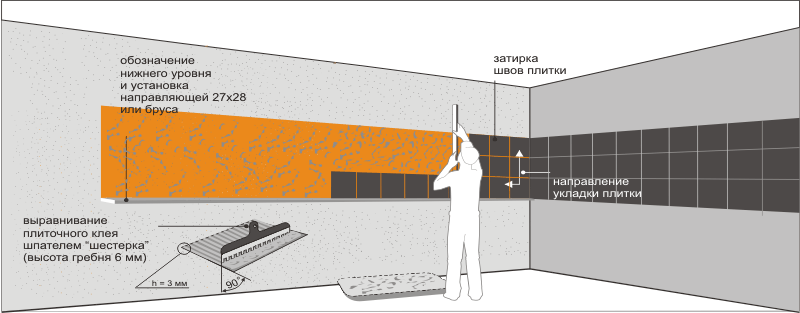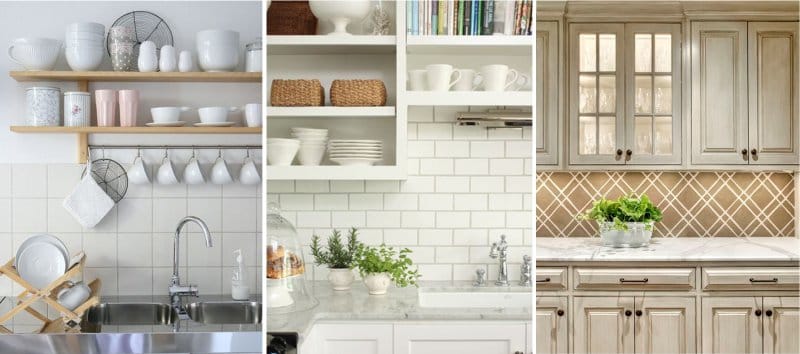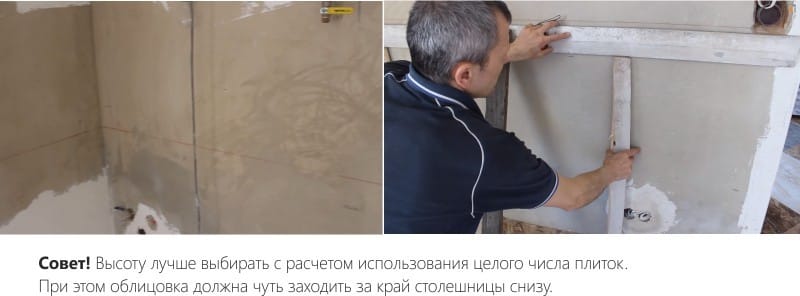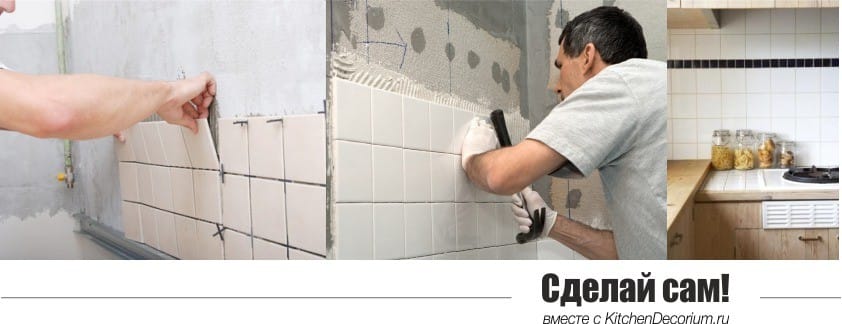Laying tiles in an apron in the kitchen can not be trusted to all professionals. It’s much safer to do it yourself, even if you have no experience. The main thing is to know how to lay tiles correctly. And when your apron is ready, you will be surprised how it was not difficult.

Determine the size of the apron and calculate the material
To make an apron in the kitchen with your own hands, you need to determine the consumption of material. And for this - specify the size of the area on which the work will be carried out. Here you can rely on the standard parameters:
- The entire working area is about 55-75 cm in height from the level of the countertop, although it can reach the floor itself - much depends on the location of the kitchen pedestals;
- Ceramic tiles must go under the tabletop at least 20 mm - so that dirt and water do not accumulate in the joints;
- On top of the installation of the apron is made to the hood - this technique is mounted at a height of 65 or 75 cm from the electric and gas stove, respectively;
- The size of the working surface horizontally is the entire length of the corresponding wall, although it can only be limited to the “sink-work table-stove” area.
Be sure to do all the necessary calculations. And for this - decide how you lay out the apron. There are many ways of laying, but among them are the most popular:
- Standard (basic);
- Diagonal;
- Imitating brickwork.

The easiest way to do it yourself is to use the basic method, and in this case material overruns will be minimal.
Tip! Do not forget that in the process of work possible damage to the material, chips, and so on. Therefore, tile is always purchased with a 10% minimum stock.
See also the material: How to choose a tile for the apron: 12 nuances and an overview of popular formats
What we need
To lay out a kitchen apron with your own hands, you will need accessories:
- Punch for cleaning from the old coating;
- Screwdriver, supplemented with a special device for mixing the adhesive composition - a mixer;
- Buckets for water and glue with a capacity of not less than 10 liters each;
- Spatula for work with glue mix: narrow for - set of glue, notched - for distribution, rubber - for work with seams;
- Construction levels - short - to check the location of each individual tile and long - to check the entire plane;
- Plitkorez and nippers, a bar from an abrasive for cutting of a tile, correction of breakaway sites;
- Rubber mall to check the fit of the apron;
- Crosses and pegs, allowing you to set the thickness of the seam;
- Solid pencil, ruler;
- Cord (punching).
Preparing the walls
After the whole tool is prepared, you need to start preparing the working surface.
- The wall is qualitatively cleared from the previous coating. If a tile was laid on the wall, then a puncher will be needed to clean it and the old mortar.In any case, the surface is cleaned up to the plastering layer.
- The density of the plastering layer should also be checked - the exfoliating elements are completely removed, after which all irregularities are sealed.
- It is important to make a perfectly flat corner if the tile moves from wall to wall.
- It is advisable to make notches in the wall so that the glue mortar will clutch better with its surface.

Tip! If there are salts, fungus or mold spots on the cleaned surface, it should be treated with a quality fungicide with anti-corrosion properties.
Getting Started Step by Step
Step 1. At the first stage, we do our own markup. Apron size, its upper and lower bounds, you must determine, based on the dimensions of the headset. As a rule, the distance from the floor to the lower edge of the apron is 70-85 cm. And the height of the apron is 55-65 cm.
Tip! Where to start laying tiles from the center or from the edge, moving to the corner? It is up to you: if you start installation from the center, then the cut tiles will be installed along the edges and in this case they must be the same size on the right and left, otherwise the apron will not look neat. If you have corner kitchen and the edges of the apron in sight, it is better to start laying it on the edge, so that the extreme tile is intact, and the trimming is in the corner.
A flat wooden bar is installed on the horizontal level - it will support the tile from the bottom, preventing it from moving down. Sometimes for these purposes use drywall sheets or metal profiles. And in order to make a vertical mark, a plumb line is installed - the cord with the load is attached at the top of the wall and released. Under the action of gravity, the plumb line itself creates an ideal vertical.

Step 2. After applying the markup, you need to make an adhesive solution with your own hands. If the mixture is prepared incorrectly, with violations of the manufacturer's recommendations, then it will very quickly collapse and the apron will disappear.

In the process, you also can not use the dried solution and dissolve it does not work, it will lose its adhesive properties.
Step 3. Then proceed to the installation of the apron. For beginners, it is best to make an apron using a decent styling method. The size of the tile also matters - the bigger it is, the easier it is to work, and it is also easier to care for, since there are much less joints. Accordingly, the smaller the tile size, the more joints there will be and the more difficult and longer it will be to install it.
We work with our own hands in the following sequence:
- An adhesive is applied to the wall (with a narrow trowel) and is evenly distributed over its surface (with a notched trowel 3 mm). On the wall should remain an even layer of glue with grooves.

Tip! Glue can be applied not to the wall, but to the tile itself. The question of which method is safer does not have a definite answer, the opinions of the masters diverge. You can experiment and try the one and the other way. The main thing here is to properly press and seat the glue under the tile evenly.
- The tile is mounted on the wall with uniform pressure. Then we take a rubber mallet and set the tile with it (or, tapping, press down with our own hands) - this will allow the glue to settle down. If you started to put a tile from the edge, then install a corner at the same stage. After this, we check the horizontal and vertical of the laid fragment with a short level.

Tip! If the tile went wrong, you can remove it, adjust the adhesive layer and lay again. Of course, this can only be done before the mortar sets.
- All tiles in the row are glued using the same technology. The smaller the size of the tiles, the more times you will have to repeat all these manipulations.
- The next row starts to mount only after the previous one dries out. Keep in mind that the first row is the most important one, and it is better to let it dry for 1 day.
Tip! Do not forget to install crosses between tiles horizontally and vertically. This allows you to withstand the same interstitial size.
Step 4. At the last stage, the tile is trimmed and the resulting pieces are laid. The cut line is carried out with a ruler on the back side, after which a tile cutter (manual or electric), a grinder or a glass cutter is used.

So you can get any size of the fragment, as well as cut the necessary recesses for sockets and pipes in the tile.


It is only important not to cut the tile on the front side - so the material will crack in the wrong place. The holes in the tiles are made with a carbide drill and also only from the "inside".
Step 5. After all the tiles laid by your own hands are dry, you need to tap it with a mallet. A thud indicates a poor fit of the tile. Such elements are removed and re-laid.
Step 6. After doubts about the quality of the laying will not remain, you can begin to grout the tile joints. In addition, before treating the seams, all tiles must be washed from repair dust. The grout is rubbed into the seams with a rubber trowel and left for 0.5-1 hours to dry, after which it is leveled and wiped with a damp cloth.
Tip! Do not forget that the shading should be in harmony with the color of the tile. Ideally, it will be 1 tone darker.
- All about grouting for tiles - ranking the best manufacturers and a 4-step optional guide
- Apron from the tile "hog" in the interior of the kitchen - from the choice of design to laying your own hands
- How to choose an apron for the kitchen - Help for the buyer
- White apron - the perfect solution for any kitchen
- All about kitchen mosaic apron and more
- Design of wall and floor tiles: size, color, successful combinations



 (Rate the material! Already voted:65 average rating: 4,57 from 5)
(Rate the material! Already voted:65 average rating: 4,57 from 5)
Category "bad advice" -
It is only important not to cut the tile on the front side - so the material will crack.
not in the right place. The holes in the tile are made with a carbide drill and
also only from the "inside".